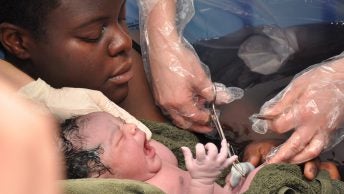I remember distinctly when The Business of Being Born, the documentary produced by famed talk show host Ricki Lake, was released. It was 2007 and she had just had her first child. She was disheartened by her birth experience. I was a recently board-certified obstetrician gynecologist who prided myself on providing quality medical care to women throughout their perinatal courses that aligned with their thoughts and desires… and I felt attacked. Midwives-good, doctors-bad. This documentary-driven battle call was foreign to me. I had “grown-up” in a collaborative model of obstetrics care. Certified nurse midwives and physicians worked side by side on labor and delivery during my residency training and throughout the next 15 years of my career.
One midwife, a unique personality who I remember fondly as traveling everywhere with her walking stick, took young physicians under her wing. She taught us about normal labor and empowering women. She thrived on guiding us through unmedicated deliveries with women in positions other than lying on their backs in a broken-down bed. She also meticulously adhered to the best evidence available for the practice of obstetrics. I learned how to maintain calm in the delivery room when my patient was in the throes of transition and more importantly, I learned how to really hear what my patients wanted during their birth experiences. I would review their birth plans with an open mind and would accommodate their desires when I could and explain non-judgmentally when their wishes were in conflict with hospital policy or my medical expertise. This small act made all the difference in our partnership.
As junior faculty, I found myself pregnant and I was excited by the prospect of experiencing an unmedicated birth. My first delivery, while a truly amazing experience, was dimmed by an overly dense epidural that took far too long to place. A dear friend who was a prior labor and delivery nurse from my residency days was a newly graduated certified nurse midwife employed at the hospital where I would deliver. I was so happy to have her there with me, coaching me through my labor and handing my newborn son to me. A few years later, she asked me to deliver her baby, and I was able to return the favor of placing her newborn son on her belly.
When I became an obstetrics and gynecology residency program director, I continued to foster the relationship between obstetricians and certified nurse midwives. They were part of our educational curriculum and the residency evaluation process. I looked to them to teach my budding obstetricians prenatal care in a centering model and what is normal in pregnancy while the physician faculty focused on teaching the intricacies of medical disease processes or surgical complications. It was a truly symbiotic relationship, as it had been my entire career. And so, I pose the question…why can’t we all work together, on the same team? In the next decade there will be a quantifiable shortage of obstetricians in the United States at the same time the average age and medical complexity of pregnant women increases. Studies* have long shown that uncomplicated patients followed by midwives have lower rates of cesarean delivery. Yet, preterm labor and postpartum hemorrhage remain unpredictable and obstetricians are an essential part of the equation. In order to provide this necessary and safe service to women and their families, we must acknowledge that physicians and midwives need to work together, as they always have in my professional life. We need to partner in this endeavor so that every midwifery student and obstetrics and gynecology resident can benefit from the totality of expertise in the field and enjoy #ExpectingMore in their training.
Dr. Farrell received her undergraduate degree from the United States Naval Academy in Annapolis, Maryland. She then went on to medical school at Washington University in St. Louis. Her residency in Obstetrics and Gynecology was completed at Naval Medical Center San Diego. She is a veteran after serving over twenty years in the United States Navy as a comprehensive obstetrician gynecologist. Her time in the Navy took her to 29 Palms CA, Camp Pendleton CA, Rota Spain and Naval Medical Center San Diego where she served as the OBGYN Residency Program Director from 2012-2018. She retired from the Navy in 2019 and joined the faculty at Beth Israel Deaconess Medical Center and Harvard Medical School Department of Obstetrics, Gynecology and Reproductive Biology. Additionally, she is Associate Faculty at Ariadne Labs working with the Delivery Decisions Initiative. Her interests within the field of OBGYN are medical education, intimate partner violence, vaginal surgery and collaborative models of care for obstetrics. She is an active member of the American College of Obstetricians & Gynecologists, the American Board of Obstetrics & Gynecology and the Society of Specialists in General Obstetrics & Gynecology.
* Souter V, Nethery E, Kopas ML, Wurz H, Sitcov K, Caughey A. Comparison of midwifery and obstetric care in low-risk hospital births. Obstet Gynecol. 2019 134(5):1056-1065.
Davis LG, Riedmann GL, Sapiro M, Minogue JP, Kazer RR. Cesarean section rates in low-risk private patients managed by certified nurse-midwives and obstetricians. J Nurse Midwifery. 1994 Mar-Apr;39(2):91-7.



